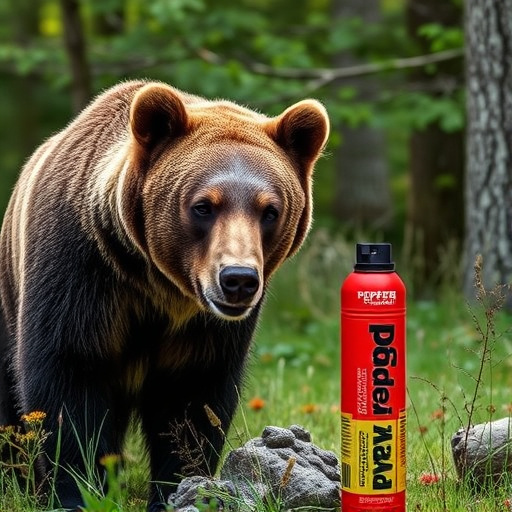Understanding wind direction is crucial for bear spray safety. Aim at the bear's eyes/nose, 20-30 feet away, with the wind blowing away from you. This technique ensures spray deters bears without returning towards the user. Monitor weather conditions affecting range and stay calm during encounters. Practice drills with varied winds to master deployment and maintain distance for safety.
Bear deterrent spray is a crucial tool for anyone venturing into bear country. Understanding its effectiveness, especially in relation to wind direction, can significantly enhance your safety. This article guides you through navigating the intricacies of bear spray range and protection. We explore essential safety tips for optimal use, help choose the right product based on distance requirements, and offer training suggestions to ensure preparedness. Remember, knowledge is key; stay safe with the right bear spray techniques.
- Understanding Bear Spray Effectiveness
- Wind Direction: Maximizing Protection
- Safety Tips for Optimal Use
- Choosing the Right Bear Spray Range
- Training and Practice Drills
Understanding Bear Spray Effectiveness
Bear spray, also known as bear deterrent spray or pepper spray for bears, is a popular tool for outdoor enthusiasts navigating bear country. Understanding its effectiveness is crucial when considering maximum range protection. One key factor is wind direction. Spraying directly into the face of an approaching bear is unlikely to be successful; the spray will blow back onto you. For optimal safety tips, it’s recommended to aim for the bear’s eyes and nose from a safe distance, usually around 20-30 feet (6-9 meters). The wind should be blowing away from you, ensuring the spray does not return towards your direction.
The range of bear spray varies based on factors like can size, spray mechanism, and ambient conditions. Typically, the effective range is about 20 to 30 feet (6 to 9 meters), but this can be reduced in strong winds or when the spray is affected by humidity. Knowing these safety tips and understanding the spray’s effectiveness can make a significant difference in bear interactions, providing maximum protection during outdoor adventures in bear-inhabited areas.
Wind Direction: Maximizing Protection
Understanding the wind direction is a crucial safety tip when using bear spray. Aiming directly at the bear, with the spray blowing back towards you, ensures maximum protection. When carrying out this technique, it’s important to assess the wind patterns in your specific environment. If possible, face into the wind while deploying the spray, creating a barrier that can protect you from any potential bear attacks.
By understanding and utilizing the wind direction effectively, users can enhance their safety during encounters with bears. This simple yet effective technique complements other deterrents, providing an extra layer of protection in areas known for bear activity. Remember, staying calm and following these safety tips can significantly improve outcomes during potentially dangerous situations.
Safety Tips for Optimal Use
When using bear deterrent spray, understanding the wind direction is crucial for optimal protection. Always spray into the wind, aiming for a 30-degree angle away from yourself. This ensures the spray reaches the bear effectively while minimizing backsplash onto the user. Check the label for specific instructions regarding wind conditions and recommended usage.
Safety tips include remaining calm and aware of your surroundings. Keep an eye on the bear’s movements and be prepared to adjust your position if needed. After spraying, create distance and provide the bear with an escape route. Never turn your back on a bear or run, as this may trigger their predatory instincts. Ensure you are within the maximum range indicated, usually around 20-30 feet, for the best results.
Choosing the Right Bear Spray Range
When selecting a bear deterrent spray, understanding its maximum range is crucial for effective protection during outdoor adventures in bear country. The ideal scenario is to choose a product that offers a range sufficient to provide a safe distance from potential bear encounters. However, it’s essential to consider the wind direction as part of your safety tips when using bear spray.
A good rule of thumb is to select a spray with a range that allows you to maintain at least 20-30 meters (65-100 feet) from bears at all times. Keep in mind that wind conditions can affect the spray’s reach, so always aim slightly ahead of your target and be prepared to move quickly if needed. By understanding these safety tips and choosing the right bear spray range, you enhance your chances of staying safe during outdoor activities in areas where bears roam.
Training and Practice Drills
When preparing for potential bear encounters, training and practice drills are essential components of any bear deterrent spray regimen. It’s crucial to simulate real-world scenarios while adhering to safety tips. Practicing with varying wind directions helps individuals learn how to deploy the spray effectively, ensuring maximum range protection.
During these drills, it’s important to focus on proper technique, including understanding the optimal distance for spraying and knowing how to control the spray’s direction. Regular training sessions in diverse environments can significantly enhance an individual’s ability to respond calmly and confidently when faced with a bear encounter.
Bear deterrent spray offers a valuable tool for outdoor enthusiasts navigating bear country. By understanding its effectiveness, optimizing wind direction, adhering to safety tips, and choosing the appropriate range, you can maximize protection and enhance your overall experience. With proper training and practice, you’ll be well-prepared to face potential encounters with these majestic yet wild animals. Remember, knowledge is key when it comes to staying safe in bear country.
